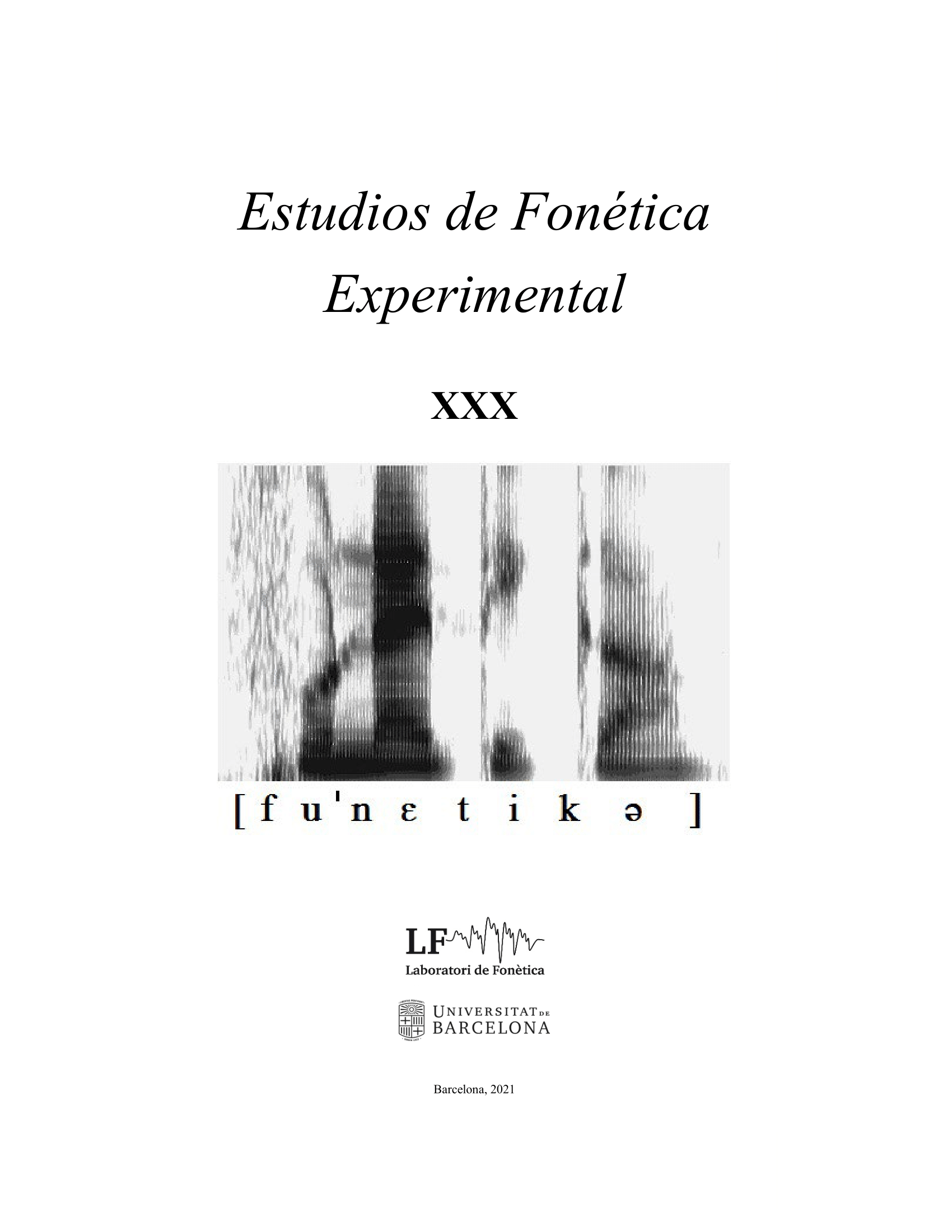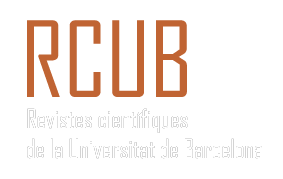International survey on voice quality
Forensic practitioners versus voice therapists
DOI:
https://doi.org/10.1344/efe-2021-30-9-34Keywords:
voice quality, forensic phonetics, methodologies, reliability, international surveyAbstract
In recent years, numerous investigations have focused on voice quality (VQ) for forensic purposes. These studies notwithstanding, we lack an international picture of how VQ is generally understood by forensic practitioners and how it contrasts with the practices of voice therapists. To fill this gap, a survey was designed and sent to both cohorts: forensicists and clinicians. A total of 45 responses from 20 countries were received. Important differences were found between groups, particularly regarding perceptual assessment. One conclusion to be drawn is that more emphasis should be placed on calibration and error measurement in forensic approaches to VQ. Further collaborations with clinicians should also be encouraged.
References
Abercrombie, D. (1967). Elements of general phonetics. Edinburgh University Press.
Barsties, B. & De Bodt, M. (2015). Assessment of voice quality: current state-of-the-art, Auris Nasus Larynx, 42(3), 183-188. https://doi.org/10.1016/j.anl.2014.11.001
Beck, J.M. (2005). Perceptual analysis of voice quality: the place of vocal profile analysis. In W.J. Hardcastle & Beck, J. M. (Eds.), A figure of speech: A Festschrift for John Laver. Routledge (pp. 285-322). Routledge.
Beck, J.M. (2007). Vocal profile analysis scheme: a user's manual. Queen Margaret University College-QMUC, Speech Science Research Centre.
Beresford, D.V., Stotesbury, T., Langer, S.V., Illes, M., Kyle, C.J. & Yamashita, B. (2020). Bridging the gap between academia and practice: Perspectives from two large-scale and niche research projects in Canada, Science & Justice, 60(1), 95-98. https://doi.org/10.1016/j.scijus.2019.09.005
Boersma, P. & Weenink, D. (2005). Praat v.5.2.01, www.praat.org [11/11/2012].
Carding, P., Carlson, E., Epstein, R., Mathieson, L. & Shewell, C. (2001). Re: Evaluation of Voice Quality, Letters to Editor. International Journal of Language and Communication Disorders, 36, 127-143.
Donnelly, R. (2019). Cross disciplinary collaboration in the current market place, Science & Justice, 59(6), 678-679. https://doi.org/10.1016/j.scijus.2019.07.002
French, P., Foulkes, P., Harrison, P., Hughes, V., San Segundo, E. & Stevens, L. (2015). The vocal tract as a biometric: output measures, interrelationships, and efficacy, In M. Wolters, J. Livingstone, B. Beattie, R. Smith, Rachel, M. MacMahon […] & Scobbie, J. (Eds.), Proceedings of the 18th International Congress of Phonetic Sciences 2015, Glasgow, UK (ICPhS 18).
Granqvist, S. (2020). Tolvan Data 2020, www.tolvan.com.
Gil, J., & San Segundo, E. (2014). La cualidad de voz en fonética judicial. In E. Garayzábal, M. Jiménez & M. Reigosa (Eds.), Lingüística Forense: La lingüística en el ámbito policial y judicial (pp. 153-197). Euphonía Ediciones.
Gómez-Vilda, P., San Segundo, E., Mazaira, L., Alvarez, A. & Rodellar, V. (2014). Using dysphonic voice to characterize speaker's biometry, Language and Law/Linguagem e Direito, 1(2), 42-66.
Hammarberg, B. (1986). Perceptual and acoustic analysis of dysphonia (Unpublished doctoral dissertation). Karolinska Institute, Stockholm.
Hirano, M. (1981). Clinical Examination of Voice. Springer Verlag.
Hughes, V., Harrison, P., Foulkes, P., French, P., Kavanagh, C. & San Segundo, E. (2017). Mapping across feature spaces in forensic voice comparison: the contribution of auditory-based voice quality to (semi-) automatic system testing, Proceedings of Interspeech, pp. 3892-3896. https://doi.org/10.21437/Interspeech.2017-1508
Kaplan, J., Ling, S. & Cuellar, M. (2020). Public beliefs about the accuracy and importance of forensic evidence in the United States, Science & Justice, 60 (3), 263-272. https://doi.org/10.1016/j.scijus.2020.01.001
Keller, E. (2005). The Analysis of Voice Quality in Speech Processing. In: Chollet G., Esposito A., Faundez-Zanuy M., Marinaro M. (Eds.), Nonlinear Speech Modeling and Applications. Lecture Notes in Computer Science (pp. 54-73). Springer, Berlin, Heidelberg.
Kempster, G.B., Gerratt, B. R., Verdolini, K., Barkmeier-Kraemer, J. & Hillman, R. E. (2009). Consensus auditory-perceptual evaluation of voice: Development of a standardized clinical protocol, American Journal of Speech Language Pathology, 18, 124-132. https://doi.org/10.1044/1058-0360(2008/08-0017)
Laver, J. (1980). The phonetic description of voice quality. Cambridge University Press.
Mattijssen, E. J., Witteman, C. L., Berger, C. E., & Stoel, R. D. (2020). Cognitive biases in the peer review of bullet and cartridge case comparison casework: A field study, Science & Justice, 60 (4), 337-346. https://doi.org/10.1016/j.scijus.2020.01.005
Morrison, G.S. (2009). Forensic voice comparison and the paradigm shift, Science & Justice, 49, 298-308. https://doi.org/10.1016/j.scijus.2009.09.002
Nawka, T., Anders, L.C., Wendler, J. (1994). The auditory assessment of hoarse voices according to the RBH system, Language Voice Hearing, 18, 130-113.
Nemr, K., Lehn, C. (2010). Voz em Câncer de Cabeça e Pescoço. In: Fernandes, F.D.M., Mendes, B.C.A., Navas, A.L.P.G.P. (2ª Ed). Tratado de Fonoaudiologia. São Paulo, Editora Roca Ltda, pp. 787-802.
Nolan, F. (1982). The Phonetic Description of Voice Quality by John Laver (Review), Journal of Linguistics, 18 (2), 442-454. https://doi.org/10.1017/S0022226700013724
Orozco-Arroyave, J.R., Vásquez-Correa, J.C., Vargas-Bonilla, J.F., Arora, R., Dehak, N., Nidadavolu, P.S.... & Vann, A. (2018). NeuroSpeech: An open-source software for Parkinson's speech analysis, Digital Signal Processing, 77, 207-221. https://doi.org/10.1016/j.dsp.2017.07.004
Park, S.J., Afshan, A., Kreiman, J., Yeung, G. & Alwan, A. (2019). Target and Non-target Speaker Discrimination by Humans and Machines. In ICASSP 2019-2019 IEEE International Conference on Acoustics, Speech and Signal Processing (ICASSP) (pp. 6326-6330). https://doi.org/10.1109/ICASSP.2019.8683362
Passetti, R. & Constantini, A.C. (2019). The effect of telephone transmission on voice quality perception, Journal of Voice, 33 (5), 649-658. https://doi.org/10.1016/j.jvoice.2018.04.018
Rose, P. & Wang, B. X. (2016). Cantonese forensic voice comparison with higher-level features: likelihood ratio-based validation using F-pattern and tonal F0 trajectories over a disyllabic hexaphone. In Proceedings of Odyssey (pp. 326-333). https://doi.org/10.21437/Odyssey.2016-47
San Segundo, E., Foulkes, P., French, P., Harrison, P., Hughes, V., & Kavanagh, C. (2018). Cluster analysis of voice quality ratings: identifying groups of perceptually similar speakers. In Proceedings of the Conference on Phonetics & Phonology in German-speaking countries (P&P 13), Humboldt Universität zu Berlin, pp. 173-176.
San Segundo, E., Foulkes, P., French, P., Harrison, P., Hughes, V. & Kavanagh, C. (2019). The use of the Vocal Profile Analysis for speaker characterization: Methodological proposals, Journal of the International Phonetic Association, 49(3), 353-380. https://doi.org/10.1017/S0025100318000130
San Segundo, E. & Gómez-Vilda, P. (2014). Evaluating the forensic importance of glottal source features through the voice analysis of twins and non-twin siblings, Language and Law = Linguagem e Direito, 1(2), 22-41.
San Segundo, E. & Mompeán, J. (2017). A simplified vocal profile analysis protocol for the assessment of voice quality and speaker similarity, Journal of Voice, 31(5), 644-e11. https://doi.org/10.1016/j.jvoice.2017.01.005
San Segundo, E., Schwab, S., Dellwo, V., He, L. & Mompeán, J. (2017). Perception of vocal tract tension: exploring possible prosodic correlates, in Current Trends in Experimental Phonetics: Cross-disciplines in the Hundredth Anniversary of Manual de Pronunciación Española (Tomás Navarro Tomás), pp. 79-82, 2017.
San Segundo, E. & Skarnitzl, R. (In Press). A computer-based tool for the assessment of voice quality through visual analogue scales: VAS-Simplified Vocal Profile Analysis, Journal of Voice.
San Segundo, E., Univaso, P. & Gurlekian, J. (2019). Sistema multiparamétrico para la comparación forense de hablantes, Estudios de Fonética Experimental, 28, 13-45.
San Segundo, E. & Yang, J. (2019). Formant dynamics of Spanish vocalic sequences in related speakers: A forensic-voice-comparison investigation, Journal of Phonetics, 75, 1-26. https://doi.org/10.1016/j.wocn.2019.04.001
Shewell, C. (2013). Voice work: art and science in changing voices. John Wiley & Sons.
Trask, R.L. (2004). A dictionary of phonetics and phonology, Routledge. https://doi.org/10.4324/9780203695111
Tsanas, A., San Segundo, E., Gómez-Vilda, P. (2017). Exploring pause fillers in conversational speech for forensic phonetics: Findings in a Spanish cohort including twins, in Proceedings of ICPRS 2017: 8th International Conference on Pattern Recognition Systems (pp. 32-37). https://doi.org/10.1049/cp.2017.0161
Downloads
Published
How to Cite
Issue
Section
License
Copyright (c) 2021 Eugenia San Segundo

This work is licensed under a Creative Commons Attribution-NonCommercial-NoDerivatives 4.0 International License.
All articles published online by Estudios de Fonética Experimental are licensed under Creative Commons Attribution-NonCommercial-NoDerivs 4.0 International (CC BY-NC-ND 4.0 DEED), unless otherwise noted. Estudios de Fonética Experimental is an open access journal. Estudios de Fonética Experimental is hosted by RCUB (Revistes Científiques de la Universitat de Barcelona), powered by Open Journal Systems (OJS) software. The copyright is not transferred to the journal: authors hold the copyright and publishing rights without restrictions. The author is free to use and distribute pre and post-prints versions of his/her article. However, preprint versions are regarded as a work-in-progress version used as internal communication with the authors, and we prefer to share postprint versions.




